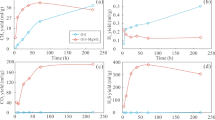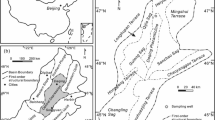Abstract
Kinetic experiments of gas generation for typical samples of marine gas precursors including low-maturity kerogen, residual kerogen and oil as well as dispersed liquid hydrocarbon (DLH) in source rocks were performed by closed system, and the evolution trends of molecular and isotopic compositions of natural gases from different precursors against the maturity (R 0%) at laboratory conditions were analyzed. Several diagrams of gas origin were calibrated by using the experimental data. A diagram based on the ratio of normal and isomerous butane and pentane (i/nC4 − i/nC5) was proposed and used to identify the origins of the typical marine natural gases in the Sichuan Basin and the Tarim Basin, China. And the maturities of natural gases were estimated by using the statistical relationships between the gaseous molecular carbon isotopic data and maturities (δ13C-R 0%) with different origins. The results indicate that the molecular and isotopic compositions of simulated gases from different precursors are different from each other. For example, the dryness index of the oil-cracking gas is the lowest; the dryness indices of gases from DLH and kerogen in closed system are almost the same; and the dryness index of gases from residual kerogen is extremely high, indicating that the kerogen gases are very dry; the contents of non-hydrocarbon gases in kerogen-cracking gases are far higher than those in oil-cracking and DLH-cracking gases. The molecular carbon isotopes of oil-cracking gases are the lightest, those of kerogen in closed system and GLH-cracking gases are the second lightest, and those of cracking gases from residual kerogen are the heaviest. The calibration results indicate that the diagrams of In(C1/C2)-In(C2/C3) and δ4 3C2-δ4 3C3-In(C2/C3) can discriminate primary and secondary cracking gases, but cannot be used to identify gas origin sources, while the diagram of i/nC4 − i/nC5 can differentiate the gases from different precursors. The application results of these diagrams show that gas mixtures extensively exist in China, which involved the gases from multiple precursors and those from different maturity stages. For example, marine gases in the Sichuan Basin involve the mixture of oil-cracking gases and high-over-maturated kerogen gases, while those in the Tarim Basin involve not only the mixture of gases from multiple precursors, but also those from different maturity gases and post-reservoir alternations such as oxidized degradation and gas intrusion processes.
Similar content being viewed by others
References
Behar F, Kressmann S, Rudkiewicz L, et al. Experimental simulation in a confined system and kinetic modeling of kerogen and oil cracking. Org Geochem, 1992, 19(1–3): 173–189
Song Y, Zhao W Z, Xia X Y, et al. The exploration orientation transferring of natural gases in China. Nat Gas Ind (in Chinese), 2002(2): 3–7
Zhao W Z, Wang Z C, Wang H J, et al. Geological characteristic of large-mid scale gas fields discovered recently in China and natural gas prospecting in the early 21st century. Nat Gas Geosci (in Chinese), 2005, 16(6): 687–692
Zhao W Z, Wang H J, Wang Z Y, et al. The new progresses on basic studies of natural geology and the significance of exploration. Prog Nat Sci (in Chinese), 2006, 16(4): 393–399
Zhao W Z, Wang Z Y, Zhang S C, et al. Oil cracking: an important way for highly efficient generation gas from marine source rock kitchen. Chin Sci Bull, 2005, 50(22): 2628–2635
Prinzhofer A, Huc Y. Genetic and post-genetic molecular and isotopic fractionations in natural gases. Chem Geol, 1995, (126): 281–290
Zhao M J, Zeng F G, Qin S F, et al. Two pyrolytic gases found and proven in Tarim Basin. Nat Gas Ind (in Chinese), 2001, 21(1): 35–38
Zhao M J, Zhang S C, Liao Z Q. The cracking gas from crude oil and its significance in gas exploration. Petrol Explor Dev (in Chinese), 2001(4): 47–49
Wang H J, Zhou X X. Formation modes of typical marine origin pools in Tarim Basin. Acta Petrol Sin (in Chinese), 2001, 22(1): 14–18
Chen S J, Ma L Y, Fu X W, et al. Genetic discrimination of marine saprogenic type gas in Tarim Basin. Oil & Gas Geol (in Chinese), 2001, 22(2): 100–101
Yin C H, Wang T D, Wang S Y, et al. Differences between kerogen and oil-cracked gases in Sinian Reservoirs of Weiyuan and Ziyang Area. Acta Sedimentol Sin (in Chinese), 2001, 19(1): 156–160
Wang Y P, Zhang S C, Wang F Y, et al. Thermal cracking history by laboratory kinetic simulation of Paleozoic oil in eastern Tarim Basin, NW China, implications for the occurrence of residual oil reservoirs. Org Geochem, 2006, 37(12): 1803–1815
Wang Y P, Wang Z Y, Zhao C Y, et al. Kinetics of hydrocarbon gas generation from marine kerogen and oil: implications for the origin of natural gases in the Hetianhe Gasfield, Tarim Basin, NW China. J Petrol Geol, 2007, 30(4): 339–356
Sweeney J J, Burnham A K. Evaluating of a simple model of vitrinite reflectance based on chemical kinetics. AAPG Bull, 1990, 74(10): 1559–1670
Hikita T, Takahashi I, Yoshimichi T. Hydropyrolysis of heavy oils. Fuel, 1989, (68): 1140–1144
Prinzhofer A A, Mello M R, Takaki T. Geochemical characterization of natural gas: a physical multivariable approach and its applications in maturity and migration estimates. AAPG Bull, 2000, (84): 1152–1172
Chung H M, Gormly J R, Squires R M. Origin of gaseous hydrocarbons in subsurface environments: theoretical considerations of carbon isotope distribution. Chem Geol 1988, 71: 97–103
Ma Y S, Guo X S, Guo T L, et al. Discovery of the Large-scale Puguang Gas Field in the Sichuan Basin and Its Enlightenment for Hydrocarbon Prospecting. Geol Rev (in Chinese), 2005, 51(4): 477–480
Zhang S C, Zhu G Y, Liang Y B. Probe into formation mechanism of H2S and high-quality reservoirs of Puguang Large Gas Field in Sichuan Basin. Geol Rev (in Chinese), 2006, 52(2): 230–235
Liang D G, Jia C Z. Natural gas exploration achievements and its prospects evaluation in Tarim Basin. Nat Gas Ind (in Chinese), 1999, (2): 3–12
Prinzhofer A, Pernaton E. Isotopically light methane in natural gases: bacterial imprint or fractionation? Chem Geol, 1997, 142: 193–200
Hoşgörmez H, Yalçm M N, Cramer B, et al. Molecular and isotopic composition of gas occurrences in the Thrace basin (Turkey): origin of the gases and characteristics of possible source rocks. Chem Geol, 2005, 214(1–2): 179–191
Faber E, Stahl W. Geochemical surface exploration for hydrocarbons in the North Sea. Am Ass Petrol Geol Bull, 1984, 68(3): 363–386
Dai J X, Qi H F. The δ 13C-R o relationship of coal-derived hydrocarbon gases in China. Chin Sci Bull, 1989, 34(9): 690–692
Shen P, Shen Q X, Wang X B, et al. Characteristics of isotope composition of gasiform hydrocarbon and identification of coal-type gas. Sci China Ser B, 1988, 31: 734–747
Lorant F, Prinzhofer A, Behar F, et al. Carbon isotopic and molecular constraints on the formation and the expulsion of thermogenic hydrocarbon gases. Chem Geol, 1998, 147: 249–264
Author information
Authors and Affiliations
Corresponding author
Additional information
Supported by the National Basic Research Program of China (Grant No. 2007CB209501, 2001CB209101) and Knowledge Innovation Project of the Chinese Academy of Sciences (Grant No. KZCX2-YW-108, KZCX3-SW-224)
Rights and permissions
About this article
Cite this article
Wang, Y., Zhao, C., Wang, Z. et al. Identification of marine natural gases with different origin sources. Sci. China Ser. D-Earth Sci. 51 (Suppl 1), 148–164 (2008). https://doi.org/10.1007/s11430-008-5016-y
Received:
Accepted:
Published:
Issue Date:
DOI: https://doi.org/10.1007/s11430-008-5016-y




